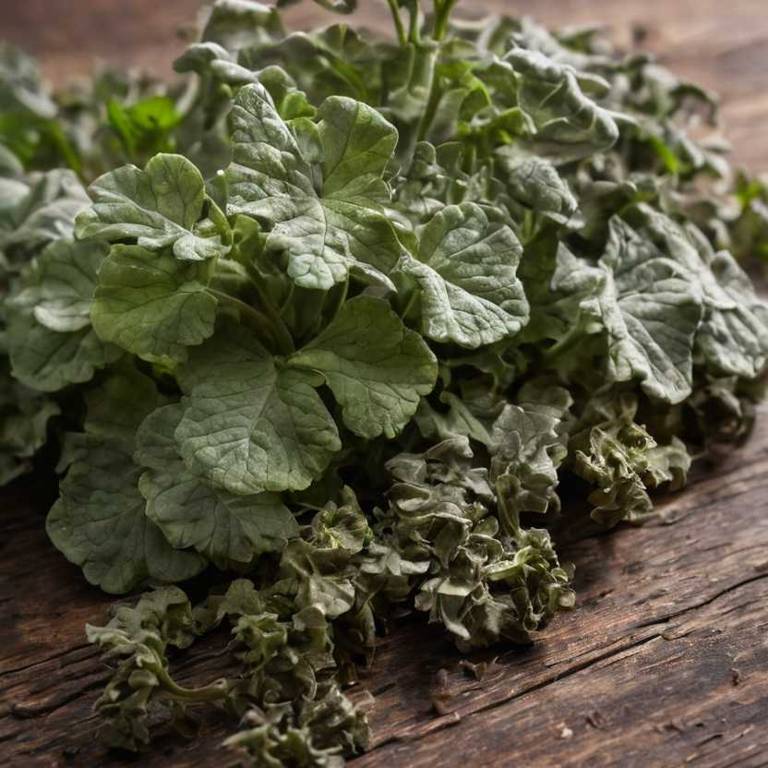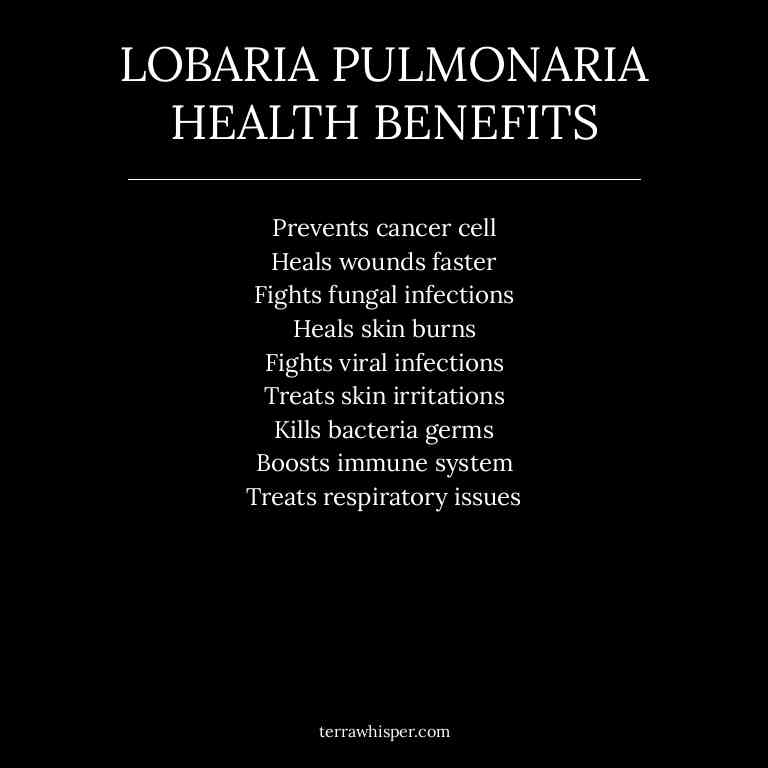Lobaria Pulmonaria Uses, Benefits, And Remedies

Lobaria pulmonaria, commonly known as lungwort, is a type of lichen that grows on tree bark and is known for its distinctive, leaf-like structures.
This herb is traditionally used in herbal medicine for its purported respiratory and immune-supporting properties.
It contains bioactive constituents such as usnic acid, lecanoric acid, and various polysaccharides, which are believed to contribute to its therapeutic actions.
Lobaria pulmonaria can be prepared as an infusion or tincture, and it is often used in formulations aimed at supporting respiratory health and boosting the immune system.
This page analize the most important medicinal aspects of Lobaria pulmonaria.
- Health Benefits
- Bioactive Constituents
- Medicinal Parts
- Herbal Preparations
- Side Effects of lobaria pulmonaria
Health Benefits
Lobaria pulmonaria prevents cancer cell growth by containing bioactive compounds that inhibit the proliferation of malignant cells and induce apoptosis, making it a promising natural agent in cancer prevention and treatment.
This lichen has also been found to accelerate wound healing due to its anti-inflammatory and antimicrobial properties, which promote tissue regeneration and reduce infection risk. Its ability to fight fungal infections stems from its rich content of secondary metabolites, which exhibit strong antifungal activity against various pathogenic fungi. Additionally, Lobaria pulmonaria aids in healing skin burns by reducing oxidative stress and inflammation, thereby promoting faster recovery and minimizing scarring.
These health benefits highlight the potential of this herb as a valuable resource in traditional and modern medicine for addressing a range of health issues.
The 10 best health benefits of Lobaria pulmonaria are shown in the image below.

The list below give a brief description of the 10 best health benefits of Lobaria pulmonaria.
- Prevents Cancer Cell: Lobaria pulmonaria contains compounds that may inhibit the growth of cancer cells by inducing apoptosis and reducing tumor formation.
- Heals Wounds Faster: The herb promotes faster wound healing by enhancing tissue regeneration and reducing inflammation in the affected area.
- Fights Fungal Infections: Lobaria pulmonaria exhibits antifungal properties that help combat fungal infections by disrupting the fungal cell membranes.
- Heals Skin Burns: The herb's anti-inflammatory and regenerative properties aid in the healing of skin burns and reduce scarring.
- Fights Viral Infections: Lobaria pulmonaria contains bioactive compounds that may inhibit viral replication and enhance the body's defense against viral infections.
- Treats Skin Irritations: The herb's soothing properties help alleviate skin irritations by reducing redness, itching, and inflammation.
- Kills Bacteria Germs: Lobaria pulmonaria has antibacterial properties that can kill harmful bacteria and prevent infections.
- Boosts Immune System: The herb supports immune function by stimulating the production of immune cells and enhancing the body's natural defenses.
- Treats Respiratory Issues: Lobaria pulmonaria may help alleviate respiratory issues by reducing inflammation and clearing mucus from the airways.
Bioactive Constituents
Lobaria pulmonaria polyphenols are a group of bioactive compounds known for their antioxidant properties, which help neutralize free radicals in the body and reduce oxidative stress.
These polyphenols contribute to the herb's ability to support immune function and may have anti-inflammatory effects. In addition to polyphenols, Lobaria pulmonaria contains quercetin, a flavonoid with potent antioxidant and anti-inflammatory properties that can help protect cells from damage.
The herb also includes terpenoids, which are organic compounds known for their diverse pharmacological activities, such as antimicrobial and antiviral effects. Carotenoids, another group of compounds found in Lobaria pulmonaria, are responsible for their vibrant colors and provide additional antioxidant support, helping to maintain overall health and wellness.
Together, these medicinal constituents make Lobaria pulmonaria a valuable natural resource with potential therapeutic applications in various health conditions.
The 9 best bioactive constituents of Lobaria pulmonaria are shown in the image below.

The list below give a brief description of the 10 best bioactive constituents of Lobaria pulmonaria.
- Polyphenols: Polyphenols are a class of bioactive compounds known for their antioxidant properties, which help neutralize free radicals and reduce oxidative stress in the body.
- Quercetin: Quercetin is a flavonoid with strong antioxidant and anti-inflammatory properties, often used to support immune function and reduce inflammation.
- Terpenoids: Terpenoids are a diverse group of organic compounds that often have antimicrobial, anti-inflammatory, and antioxidant properties.
- Carotenoids: Carotenoids are pigments found in plants that act as antioxidants, supporting eye health and immune function.
- Xylitol: Xylitol is a natural sugar alcohol with antimicrobial properties, commonly used as a sweetener and for oral health support.
- Lycopene: Lycopene is a powerful antioxidant found in red fruits, known for its protective effects against oxidative stress and potential cancer prevention.
- Flavonoids: Flavonoids are a group of plant-based compounds with antioxidant, anti-inflammatory, and vasodilatory properties, supporting overall health.
- Phenolic Acids: Phenolic acids are organic compounds with antioxidant properties that help protect cells from damage caused by free radicals.
- Glucomannans: Glucomannans are a type of soluble fiber known for their ability to absorb water, support digestive health, and aid in weight management.
Medicinal Parts
Lobaria pulmonaria, commonly known as lungwort lichen, contains various bioactive compounds such as usnic acid, atranorin, and other secondary metabolites that have been studied for their medicinal properties.
These compounds exhibit antimicrobial, antifungal, and anti-inflammatory effects, making them valuable for treating infections and inflammatory conditions. The lichen's ability to produce these compounds is attributed to its unique symbiotic relationship between algae and fungi, which enhances its chemical complexity.
Due to these properties, specific parts of Lobaria pulmonaria have been traditionally used in herbal medicine to support respiratory and immune health.
The 0 best medicinal parts of Lobaria pulmonaria are shown in the image below.

The list below give a brief description of the 0 best medicinal parts of Lobaria pulmonaria.
Herbal Preparations
Lobaria pulmonaria tinctures are prepared by soaking the dried lichen in alcohol, typically ethanol, to extract its bioactive compounds.
This method allows for the preservation of the lichen’s complex chemical profile, which includes various secondary metabolites such as usnic acid and atranorin. These tinctures are often used in traditional and alternative medicine for their purported antimicrobial, anti-inflammatory, and immunomodulatory properties. The preparation process requires careful control of concentration and drying to maintain potency and safety.
Lobaria pulmonaria tinctures are sometimes employed in herbal formulations aimed at supporting respiratory health and enhancing immune function, though their use is generally limited to specific therapeutic contexts due to the lichen’s slow growth and ecological sensitivity.
The 10 best herbal preparations of Lobaria pulmonaria are shown in the image below.

The list below give a brief description of the 10 best herbal preparations of Lobaria pulmonaria.
- Tinctures: Tinctures made from Lobaria pulmonaria are traditionally used for their potential respiratory benefits, including easing coughs and supporting lung health. They are also believed to have antimicrobial properties that may aid in treating respiratory infections.
Side Effects of lobaria pulmonaria
Lobaria pulmonaria may cause allergic reactions in individuals who are sensitive to its compounds, leading to symptoms such as hives, swelling, or even anaphylaxis in severe cases.
Prolonged or direct contact with the herb can cause skin irritation, resulting in redness, dryness, or a burning sensation on the skin. It may also induce skin rashes and trigger skin itching, particularly in those with pre-existing dermatological conditions.
Inhaling spores or particles from Lobaria pulmonaria can lead to respiratory issues, including coughing, shortness of breath, and bronchial inflammation. Additionally, it may cause throat irritation, nasal congestion, and eye inflammation, which can manifest as watery eyes, redness, or blurred vision. These side effects highlight the importance of caution when handling or using this herb, especially for individuals with known allergies or respiratory sensitivities.
It is advisable to consult a healthcare professional before incorporating Lobaria pulmonaria into any treatment regimen.
The 9 most common side effects of Lobaria pulmonaria are shown in the image below.

The list below give a brief description of the 9 most common side effects of Lobaria pulmonaria.
- May Cause Allergic Reactions: Individuals with allergies may experience symptoms such as hives, swelling, or difficulty breathing upon exposure to Lobaria pulmonaria.
- Causes Skin Irritation: Contact with the herb can lead to redness, dryness, or a burning sensation on the skin.
- Induces Skin Rashes: Prolonged or repeated contact may result in the development of skin rashes or bumps.
- Triggers Skin Itching: The herb may cause an itchy sensation on the skin, often accompanied by a rash.
- Leads To Respiratory Issues: Inhalation of spores or particles from Lobaria pulmonaria can lead to coughing, shortness of breath, or wheezing.
- Triggers Throat Irritation: Inhalation may cause a sore or irritated throat, leading to discomfort or a persistent cough.
- Causes Nasal Congestion: Exposure to the herb may result in a stuffy or blocked nose, along with sneezing or runny nose.
- Results In Nausea: Consuming or inhaling the herb may lead to feelings of nausea or an upset stomach.
- Induces Eye Inflammation: Contact with the herb can cause redness, swelling, or irritation in the eyes, potentially leading to discomfort or blurred vision.